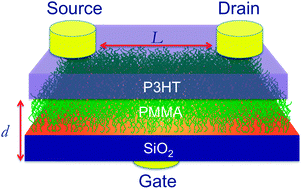All-polymer field-effect transistors using a brush gate dielectric†
Abstract
Interfaces between a poly(3-hexylthiophene) [P3HT] and an end-grafted (brush) layer of poly(methyl methacrylate) [PMMA] are shown using neutron reflectometry to be dependent on heat treatment. Annealing the samples allows part of the brush layer to cross into the P3HT layer creating a very asymmetric interface. We suggest that the P3HT rearrangement occurs, creating space for movement of the brush into the film. This interpenetration was observed with two different molecular weight (17.5 and 28 kg mol−1) P3HT films. Output characteristics of devices made from P3HT layers on PMMA brushes show that different amounts of heat treatment do not significantly change the device performance. Saturated hole mobilities are dependent on heat treatment, with devices made from a smaller molecular weight P3HT (22 kg mol−1) demonstrating larger mobilities than devices created using 48 kg mol−1 P3HT, but only after heat treatment.

- This article is part of the themed collection: Fabrication technology of nanomaterials

 Please wait while we load your content...
Please wait while we load your content...